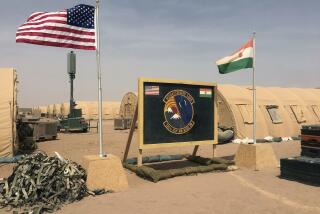143 Soldiers Put Panama Behind, Return to El Toro
- Share via
Maurice Carlisle could have been any other American wearily trying to clear Customs after a trip to an exotic, faraway country. Except that Customs in this case was a makeshift station on a Marine Corps air base and Carlisle was in fatigues and carrying a backpack.
Friday afternoon the Navy corpsman found himself standing in a Customs line at the Marine Corps Air Station in El Toro with 142 other Marines and Navy corpsmen. Six hours earlier, the soldiers were whisked away from jungle training maneuvers in Panama by a green 747-size Air Force C-141 transport plane.
“Good to be back,” Carlisle said. “A lot cooler here than it is in Panama.”
The men in Carlisle’s group were among 800 members of the Marines’ 1st Division who traveled to Ft. Sherman, an army base in eastern Panama, on April 8 to participate in jungle training exercises, Marine officials say.
The Marines, stationed at Camp Pendleton, will be brought back gradually through next weekend, with 145 more arriving at the base today and an additional 500 arriving next weekend.
The 1st Division’s presence in Panama is in no way related to U.S. attempts to oust Panamanian military leader Manuel A. Noriega, who has been accused by U.S. officials of trafficking in drugs, said Maj. Hank Polacke, public affairs officer for the division.
Central America is the closest place U.S. armed forces can go for jungle training, and the Marines were merely one of 14 Army and Marine battalions that the United States sends to Panama each year, he said.
Nevertheless, the Marine presence has been touchy, coming at the same time as the controversy over Noriega and U.S. economic sanctions against Panama. It has been especially difficult since April 12, when members of a Marine security patrol from Camp Lejeune, N.C., accidentally shot and killed one of their own near a Navy fuel dump near the western end of the Panama Canal, near Panama City. Marine officials said he was mistaken for an intruder.
The 1st Marine Division has been stationed far away from that area, Polacke said. “In fact, these folks were a significant distance--almost 50 to 60 kilometers (31 to 37 miles)--from anything that was happening in the Panama City area,” he said.
Carlisle, one of only a handful of Marines permitted by Marine Corps public relations personnel to speak to reporters, said he came into contact with very few Panamanians.
“I don’t speak Spanish, so I’d have problems talking to them anyway,” he said, seconds before being called away from reporters to join comrades who were being taken to Camp Pendleton for a reunion with family members.
Lt. William Hughes, a platoon commander with the 1st Division, said the only Panamanians he came in contact with were maintenance workers or mess hall personnel at the base. “We went down there for what we’re supposed to do: training. And that was it.”
Hughes said the Marines were “not allowed to leave the base by order of the high command,” adding that he thought the restriction was intended to keep peace with the local population.
“If they saw . . . 200 or 300 Marines moving around their cities, the people may (feel) threatened or something,” Hughes said.
Marines allowed to speak with reporters said the training was tough.
“It was getting oriented with the jungle, the terrain, getting acclimatized with the weather,” Carlisle said.
“It was learning how to deal with the jungle, move in the jungle as fast and as efficiently as possible.”
More to Read
Sign up for Essential California
The most important California stories and recommendations in your inbox every morning.
You may occasionally receive promotional content from the Los Angeles Times.













